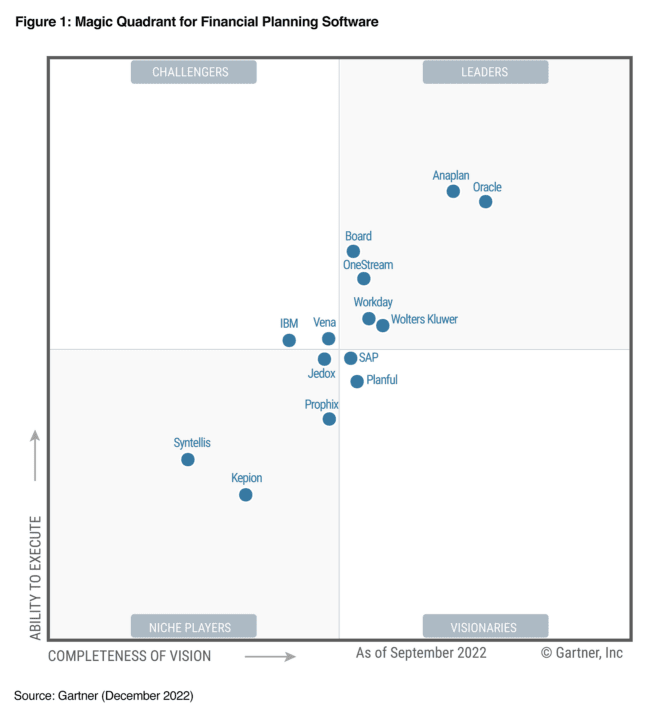Having near real-time visibility into key financial and operating metrics, and the ability to support agile planning and forecasting are essential capabilities for navigating today’s volatile global economy. The pandemic and post-pandemic economic volatility have been a wake-up call for organizations that have been relying on spreadsheets or aging planning applications that hinder agility and the ability of CFOs and their teams to partner with business leaders to react quickly to impact bottom-line performance under rapidly changing conditions. And it’s driving demand for modern, cloud-based financial planning software applications.
So it’s timely that the 2022 Gartner® Magic Quadrant™ report for Financial Planning Software1 was recently published, highlighting key market trends and providing an assessment of the top 14 vendors in the market. Read on to hear the highlights of the report.
Planning in the Cloud

According to Gartner, “Financial planning software is at the forefront of finance modernization efforts. It has taken this prominent position as CFOs and FP&A leaders assume a leading role in driving more agile, accurate and continuous companywide planning, with the aspiration to become valued strategic business partners to the rest of the enterprise.”
In the Gartner Magic Quadrant for Financial Planning Software, published in December 2022, the analyst firm highlighted how the financial planning software market has shifted from on-premises deployment to cloud, with most migrations and new implementations deployed as SaaS/cloud offerings. Why is this?
The reason is that cloud solutions are faster to deploy, easier to implement, use and maintain with little need for IT staff. They also lend themselves to broader adoption through self-service and user-friendly reporting and analytics. They support modern planning requirements such as rolling forecasts, driver-based planning and scenario modeling. And finally, cloud-based planning solutions support improved collaboration and alignment across the enterprise and between finance and operations teams.
AI-Powered Planning Will Become Mainstream
In the report, Gartner highlighted several key market trends that are driving rapid growth in the FP&A software market. This includes the following:
- CFOs are playing a more strategic role in enterprise-wide decision support
- The need to execute planning and forecasting more efficiently through automation
- Demand for improved alignment of financial plans with operational plans in IT, HR, Sales, Marketing, Supply Chain and other functions.
- Interest in predictive forecasting and tapping into larger volumes of data available from enterprise systems.
- Demand for AI and Machine Learning (ML) models that can combine internal and external data to support more intelligent forecasting and decision-making.
The report highlights that today, these more advanced forms of analytics are innovative in modern planning solutions, but Gartner predicts they will become more of a standard expectation as additional vendors include them in their offerings.
Assessing the Vendor Landscape
Of course, the key focus of any Gartner Magic Quadrant report is the assessment and grouping of the various vendors in the market as Leaders, Visionaries, Challengers or Niche vendors. So what was Gartner’s assessment of the Financial Planning software vendor landscape in 2022? Well – I am pleased to report that OneStream is positioned as a Leader, along with Oracle, Anaplan, Workday, Wolters Kluwer and Board (see figure 1).

Why was OneStream recognized as a Leader in the report? I suggest reading the entire report to get the full story, but a few strengths highlighted in the report are:
- Robust product that can collect data at different levels of granularity and connect to a wide variety of data sources.
- Extensive user capacity and performance, with the ability to support a large number of concurrent users and with our Extensible Dimensionality®
- OneStream™ MarketPlace which provides customers with access to over 50 productivity tools and business solutions they can download, configure and deploy to quickly address new requirements.
In a press release announcing OneStream being recognized again by Gartner as a leader, OneStream CEO Tom Shea commented, “We believe this recognition reflects our strong momentum in the market and the value customers gain by adopting OneStream’s unified, extensible platform to streamline their complex financial processes across planning, reporting and analytics. As Finance leaders navigate today’s complex and changing business environment, OneStream provides the trusted data-backed insights for rapid decision making and improved financial and operational performance.”
Learn More
To learn more about the key market trends, and how OneStream compares to the other vendors in the financial planning software market, download the Gartner MQ report and contact OneStream if your organization is ready to reduce reliance on spreadsheets and legacy applications and lead at speed!
1Gartner Magic Quadrant for Financial Planning Software, Regina Crowder, Matthew Mowrey, Farrah Watson 14 December 2022
GARTNER is a registered trademark and service mark of Gartner and Magic Quadrant is a registered trademark of Gartner, Inc. and/or its affiliates in the U.S. and internationally and are used herein with permission. All rights reserved.
Gartner does not endorse any vendor, product or service depicted in its research publications, and does not advise technology users to select only those vendors with the highest ratings or other designation. Gartner research publications consist of the opinions of Gartner’s research organization and should not be construed as statements of fact. Gartner disclaims all warranties, expressed or implied, with respect to this research, including any warranties of merchantability or fitness for a particular purpose.
Get Started With a Personal Demo



